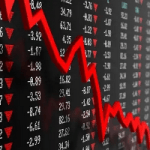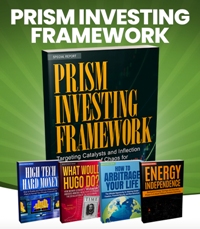 “As a dog returns to its vomit, so a fool repeats his folly.”
“As a dog returns to its vomit, so a fool repeats his folly.”
– Proverbs 26:11
You’re Fired!
Government bureaucrats thought they had it made. High paying jobs that are practically guaranteed for life. Great retirement benefits. A certain air of importance.
Now they’re walking on eggshells. Tiptoeing around. Trying to stay out of President Donald Trump’s crosshairs.
Several weeks ago, Trump fired Bureau of Labor Statistics commissioner Erika McEntarfer. If you recall, he blew a gasket following revisions to the May and June jobs report, which adjusted total jobs created from 291,000 to 33,000. He said the numbers were rigged for political reasons and gave McEntarfer a pink slip.
This week, it was Federal Reserve Governor Lisa Cook’s turn to get the boot. Cook had apparently taken liberties on several mortgage applications in 2021. She claimed two places as principal residences – in Ann Arbor, and Atlanta – to get better mortgage terms.
Trump said this fraud is sufficient cause to remove Cook from her position. Cook disagrees. She has lawyered up.
McEntarfer and Cook, from our perspective, are the lucky ones. Their jobs shouldn’t exist to begin with. Producing bogus data and price fixing interest rates are endeavors which cause more harm than good.
Thanks to Trump, they now both have the opportunity to find gainful employment doing real, useful work. Jobs like fixing leaky faucets or packing meat that provide a real benefit to society. They should be happy that they no longer must waste their lives doing garbage work.
Trump, for his part, will likely replace Cook with someone that’s one hundred percent favorable to his cause. Someone who is willing to cut rates, pump credit, and do his or her part to assist the Treasury in financing the U.S. government’s massive deficit.
Now, after getting hammered on by Trump for many months, it appears that Fed Chair Jerome Powell is finally coming around…
Transitory Inflation?
In case you missed it, the annual central banking powwow in Jackson Hole came and went last week. Fed Chair Powell, in what may be his final appearance in Jackson Hole as the world’s most important central banker, delivered a speech on Friday, August 22. There he strongly hinted that the Fed is ready to pull the trigger on a rate cut as soon as the September Federal Open Market Committee (FOMC) meeting.
Powell’s message was that the balance of economic risk is shifting. All year, the Fed has been holding the federal funds rate steady (currently between 4.25 and 4.5 percent). Over this time, inflation has ticked stubbornly higher while the labor market has cooled down, thus setting the stage for an episode of stagflation.
The Fed’s attention since Trump came into office has been focused on limiting inflation. Powell’s remarks suggest the Fed is now more worried about the economy sputtering than prices spiraling out of control.
According to Powell, it’s a “challenging situation” where, in the near term, “risks to inflation are tilted to the upside, and risks to employment to the downside.”
What exactly does that mean?
On the inflation side, Powell noted that the effects of higher tariffs across trading partners “are now clearly visible,” pushing up prices for consumers. However, he downplayed the long-term threat, stating, “A reasonable base case is that the effects will be relatively short-lived—a one-time shift in the price level. Of course, ‘one-time’ does not mean ‘all at once.’”
This is all conjecture and guesswork. The logic seems to be that if the price increases from tariffs are just a temporary, one-off ‘transitory’ event, the Fed doesn’t need to slam on the brakes with higher rates. It can afford to focus on the other half of their dual mandate: maximum employment.
Maybe so. But if you recall the last time Powell said inflation was transitory – in 2021 and 2022 – he sat on his hand while consumer prices spiraled to a 40 year high. Will he be wrong again?
Downside Risks to Employment
Powell spent part of his speech discussing the labor market. While the unemployment rate remains low, around 4.2 percent, recent jobs data, including McEntarfer’s downward revisions to previous months, has been signaling a slowdown in hiring.
Powell described the current state of the jobs market as a “curious kind of balance” resulting from both supply and demand for workers slowing. He then delivered the line that really got the markets buzzing:
“This unusual situation suggests that downside risks to employment are rising. And if those risks materialize, they can do so quickly in the form of sharply higher layoffs and rising unemployment.”
The words “downside risks to employment are rising” are about as close as a Fed Chair gets to explicitly stating a rate cut is coming. Hence, the major stock market indexes spiked up last Friday to close out the week.
So, what does this all mean for the September 16 and 17 FOMC meeting?
Before the speech, the odds of a September rate cut of 25 basis points were already relatively high. After Powell’s comments, that probability skyrocketed, with market futures now pricing in the move as an almost certain outcome. Some estimates put the probability at nearly 90 percent.
The markets believe Powell’s Jackson Hole speech was, in effect, laying the groundwork for a September cut. By cutting rates now, and making borrowing cheaper for consumers and businesses, Powell is hoping to get ahead of a cooling labor market.
Unless there’s a strong August jobs report or a dramatic inflation surge, you can be certain there will be a 25 basis point interest rate cut when the FOMC meets next month.
What to make of it?
Here Comes the September Swoon
Powell’s dovish pivot in Jackson Hole was enough to send markets rallying. Investors, anticipating a rate cut at the upcoming September 16 and 17 FOMC meeting, have been “buying the rumor” by bidding up stocks. The “sell the news” stage of the trade will come later and depends on several factors.
The market’s reaction has already priced in a significant likelihood of a rate cut. The good news is already baked into stock prices. So, the magnitude of the cut is critical. If the Fed overdelivers, with a 50 basis point rate cut, speculators will celebrate with more buying. But if there’s just a 25 basis point rate cut, followed by a somewhat hawkish Fed statement, there could be a wave of selling.
Powell’s speech was careful to say that the decision is not on a preset course. That it will depend on incoming data. Hence, investors and speculators will be closely watching new inflation and employment reports leading up to the September meeting.
If these data points surprise to the upside, the Fed could be forced to hold off on a cut, leaving investors who bought into the rumor exposed to a selloff. Regardless of the outcome, many may sell to lock in profits immediately after the FOMC meeting to avoid being caught on the wrong side of the trade.
In short, you can expect there to be wild price springs over the next three weeks…
…and don’t forget, September has historically been the worst month for the U.S. stock market, with the S&P 500 averaging negative returns since 1926. By this, conditions are ripe for a September swoon.
Prepare accordingly.
[Editor’s note: Navigating these wild market swings can be tough. But what if you had a clear framework to help you? We created the Prism Investing Framework for just this reason. It helps you see the whole picture – from macroeconomics to individual stocks – so you can make smart moves and avoid the pitfalls. Ready to see the world through a new lens?]
Sincerely,
MN Gordon
for Economic Prism
Return from Here Comes the September Swoon to Economic Prism




